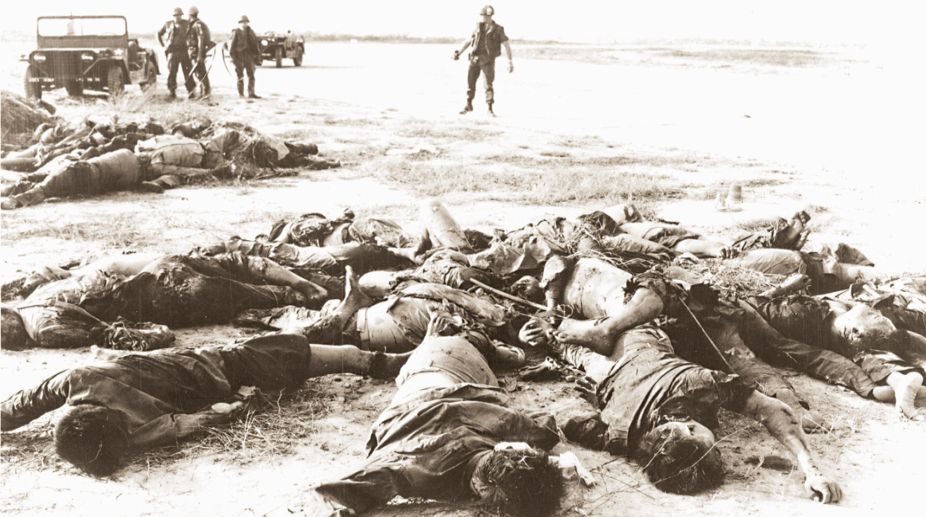One killed, three injured in explosion in paper factory in Vietnam
One paper factory worker died and two others were injured in a huge explosion in Vietnam's Bac Ninh province on Tuesday morning, Vietnam News Agency reported.

My Lai in the northeast edge of South Vietnam.
On 16 March fifty years ago, an American infantry company rampaged through the small hamlet of My Lai in the northeast edge of South Vietnam and killed more than 400 hapless women, children and elderly men.
Another bloodthirsty infantry unit a mile away that same morning mowed down nearly a hundred more unarmed villagers. The final count was inexact for decades, which says a great deal about the unimportance of the sufferers to the executioners.
The victims of the killings, maiming and rapes duly were claimed to be Vietcong guerillas in order to boost the macabre body count statistics. The only American casualty was a by self-inflicted gunshot wound.
Advertisement
Helicopter pilot Hugh Thompson and his crew valiantly swooped in to save a few villagers, threatening to shoot crazed U.S. troops who did not back off.
Thompson’s angry report of the atrocities was ignored and he was assigned afterward to extremely dangerous duties, likely in hope that he conveniently would be killed in action.
Rightwing Congressmen and other yahoos treated Thompson as a rank traitor because he threatened their shiny public relations image of the US military.
In the casual killing fields of Vietnam, it obviously was the intimate face-to-face nature of the massacre that distinguished it, as opposed to the massive civilian casualties commonly inflicted by calling in air strikes or artillery on villages from afar.
A ‘blind eye’ was what officials turned to these systematic brutalities, which they knew were inevitable. The previous year in the Central Highlands a 101st Airborne detachment called the Tiger Force blasted their way across the area with total impunity.
War correspondent Jonathan Schell testified early on that ‘the idea that the US military was operating under constraints in South Vietnam was ridiculous.’
Legendary investigative journalist Seymour Hersh eventually would manage to bring the My Lai massacre to light a year and a half later.
When in 1971 an Army jury sentenced Lieutenant Calley, and Calley alone, to life imprisonment, President Nixon ordered him placed under house arrest instead in the first of a series of sentence reductions.
Calley clearly was an appallingly bad officer, but just how did he differ from the 96 per cent of American lieutenants in a suppressed survey who said they would resort to torture if it served their missions? One wonders how, and if, they differ today? Calley ironically was completely freed three months after Nixon resigned in disgrace.
An American public in turmoil detected that Calley, though guilty, also stood in as a scapegoat for a high command encouraging the vast cruelties of counterinsurgency.
In April 1971 a Gallup poll reported 50 per cent of Americans reckoned that My Lai atrocities were a common occurrence in Vietnam while 79 per cent also thought Calley’s sentence ‘too harsh.’ ‘Seventy per cent believed the Army had let Calley take the entire blame for the killings,’ an investigator notes, ‘while 77 per cent in a Louis Harris poll believed Calley had ‘been singled out unfairly as a scapegoat.’
The American public knew, or suspected, something crucial about the harsh complexities of military service.
There undeniably was a diehard segment – as much as a third of the populace, who fluctuate but never go away, as Trump’s election attests – who endorsed an adamant authoritarian “My Country Right or Wrong.”
Nonetheless, the month following Calley’s conviction two thirds of Americans also realized that the war was ‘morally wrong’ and 3 of 5 Yanks demanded withdrawal, even if South Vietnam’s regime collapsed, as it would in 1975.
Far less heartening, half the public at the height of the My Lai revelations said they would follow orders to shoot unarmed villagers while only a third said they would not – remarkably, the same proportion as Stanley Milgram’s infamous experimental subjects at Yale.
However, the word ‘scapegoat’ was never the exact one for how the public deciphered Calley. ‘Small fry’ or ‘pawn’ might have been a more suitable term.
The public, among whom were many former military personnel, was acutely aware of the knack of the officer corps, or any other boss, for eluding blame.
Lieutenant Calley was not a scapegoat since whatever the blameworthiness of the chain of command issuing illegal orders, it ‘did not eliminate the responsibility of individual agents,’ as famed philosopher Herbert Marcuse insisted at the time.
Marcuse was assuredly right, but a vast majority saw Calley as a victim not of the Vietnamese but of arrogant domestic elites who dispatched millions of pawns like him into a situation that guaranteed atrocities. Under the right (or wrong) set of pressures ‘we are all,’ one observer lamented, ‘one step away from My Lai,’ which is a very different lesson to draw than glibly concluding ‘we’ are all to blame.
The core of the problem, the force that needs to be undone, is the ‘habit of obedience’ which lies in ‘the universal teaching of all cultures not to get out of line, not even to think about that which one has not been assigned to think about, the negative motive of not having either a reason or a will to intercede,’ as Howard Zinn argued.
‘To be realistic in dealing with a problem’, he points out, ‘is to work only among the alternatives which the most powerful in society put forth.’ Stanley Milgram arrived at much the same lesson, concluding that if we accept alternatives as authorities present them, we are doomed. Everything one can do as citizen, analyst or scholar to chip away at the obedient two-thirds (and not only in the USA) is to be welcomed.
The writers are well-known commentators and the authors of No Clean Hands, Parables of Permanent War and many other books.
Advertisement